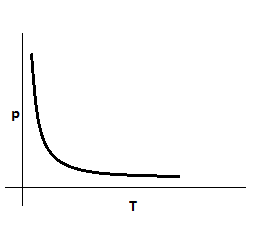
Show on a graph, the variation of resistivity with temperature for a typical semiconductor.
Answer
564.9k+ views
Hint: Recall the formula for resistivity for a semiconductor. Deduce how temperature affects the resistivity of a material. After finding out the relation, match it with the standard graphs know and then draw the required graph
Formula Used:
$\rho = \dfrac{m}{{n{e^2}\tau }}$
Complete step by step solution:
The resistivity is given by: $\rho = \dfrac{m}{{n{e^2}\tau }}$ where
$n = $ Number density of electrons
$\tau = $ Relaxation time
With the rise in temperature, the number density of electrons and holes (in case of semiconductors) increases, where τ remains constant. So, ρ (resistivity) decreases with increase in temperature.
From the above, we can infer that $\rho \propto \dfrac{1}{{\rm T}}$
Thus it is of the form $y = \dfrac{k}{x}$
The graph of it is a hyperbolic curve. Also resistivity and temperature also cannot be equal to zero or negative. Hence we get the curve only in the first quadrant.

This the required graph of the question
Additional Information: Resistivity is a property of the material. It changes with the material and temperature. It is the electrical resistance of a conductor of unit cross-sectional area and unit length.
Semiconductors are materials which have a conductivity between conductors (generally metals) and nonconductors or insulators (such as most ceramics). Semiconductors can be pure elements, such as silicon or germanium, or compounds such as gallium arsenide or cadmium selenide. The resistivity of a semiconductor decreases with temperature.
Note: This graph is unique; it is for only semiconductors. The graph is different for other materials. It is a straight line with positive slope for metals and conductors as for conductors the resistivity increases linearly with increase in temperature.
Formula Used:
$\rho = \dfrac{m}{{n{e^2}\tau }}$
Complete step by step solution:
The resistivity is given by: $\rho = \dfrac{m}{{n{e^2}\tau }}$ where
$n = $ Number density of electrons
$\tau = $ Relaxation time
With the rise in temperature, the number density of electrons and holes (in case of semiconductors) increases, where τ remains constant. So, ρ (resistivity) decreases with increase in temperature.
From the above, we can infer that $\rho \propto \dfrac{1}{{\rm T}}$
Thus it is of the form $y = \dfrac{k}{x}$
The graph of it is a hyperbolic curve. Also resistivity and temperature also cannot be equal to zero or negative. Hence we get the curve only in the first quadrant.

This the required graph of the question
Additional Information: Resistivity is a property of the material. It changes with the material and temperature. It is the electrical resistance of a conductor of unit cross-sectional area and unit length.
Semiconductors are materials which have a conductivity between conductors (generally metals) and nonconductors or insulators (such as most ceramics). Semiconductors can be pure elements, such as silicon or germanium, or compounds such as gallium arsenide or cadmium selenide. The resistivity of a semiconductor decreases with temperature.
Note: This graph is unique; it is for only semiconductors. The graph is different for other materials. It is a straight line with positive slope for metals and conductors as for conductors the resistivity increases linearly with increase in temperature.
Recently Updated Pages
A man running at a speed 5 ms is viewed in the side class 12 physics CBSE

The number of solutions in x in 02pi for which sqrt class 12 maths CBSE

State and explain Hardy Weinbergs Principle class 12 biology CBSE

Write any two methods of preparation of phenol Give class 12 chemistry CBSE

Which of the following statements is wrong a Amnion class 12 biology CBSE

Differentiate between action potential and resting class 12 biology CBSE

Trending doubts
What are the major means of transport Explain each class 12 social science CBSE

Which are the Top 10 Largest Countries of the World?

Draw a labelled sketch of the human eye class 12 physics CBSE

How much time does it take to bleed after eating p class 12 biology CBSE

Explain sex determination in humans with line diag class 12 biology CBSE

Explain sex determination in humans with the help of class 12 biology CBSE




